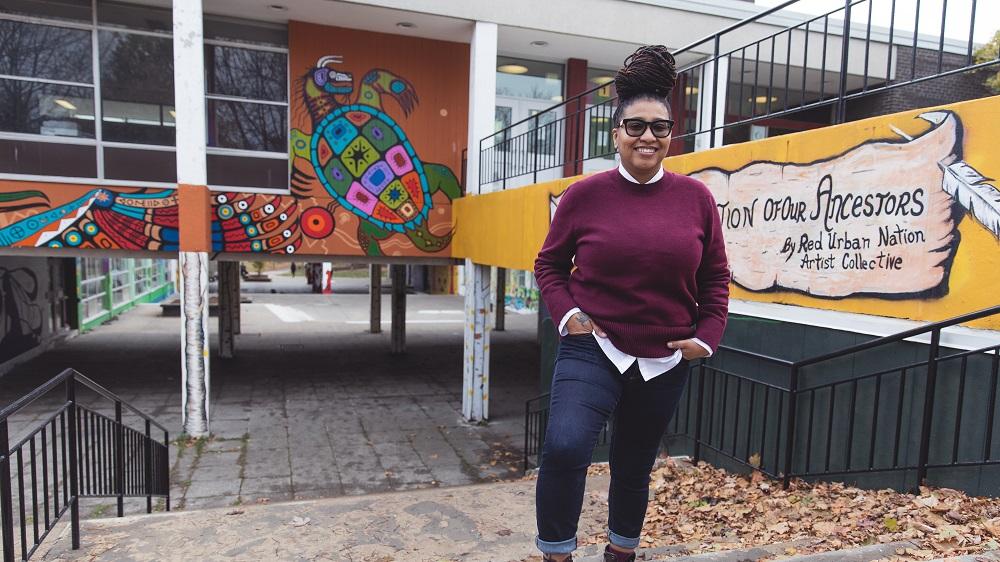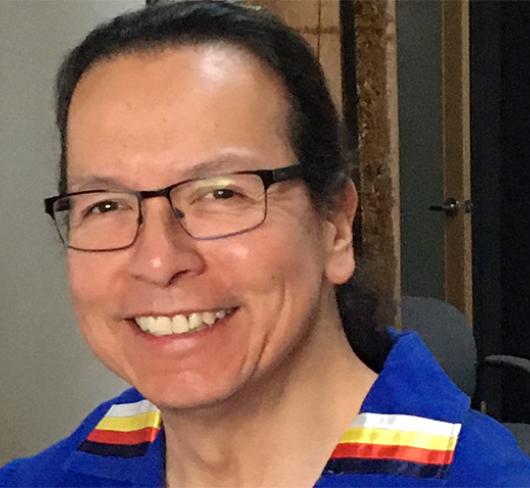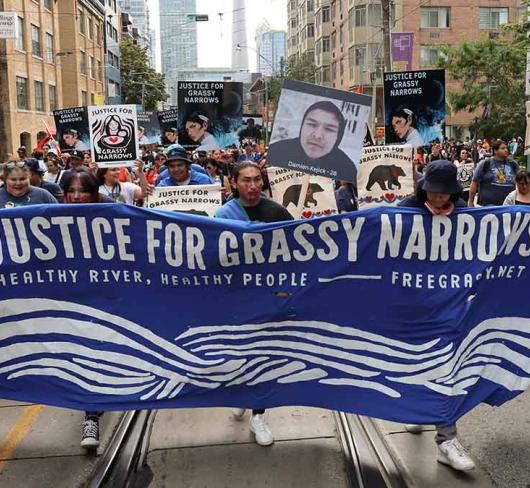
Anti-Black Racism in Education and Black Students Navigating the Pandemic
Stephanie Fearon in conversation with Black queer mother, child and youth worker, PhD student and researcher Tanitiã Munroe.
STEPHANIE FEARON: You are a Child and Youth Worker, dedicated to serving youth who have been suspended and expelled, and also a parent. How do systemic forms of oppression play out in the schooling experiences of the students you work with? How has it affected your own children?
TANITIÃ MUNROE: Institutionalized racism has a long history in the Canadian education system and continues to create barriers for Black, Indigenous and racialized students. As early as the 1800s, policies were used to refuse admission of Black children into white schools. We had discriminatory laws upheld by the courts that legally enforced and maintained racially segregated schools. Literature, reports and personal narratives document the many ways early legacies of racism persist and negatively impact the present-day schooling experiences of Black children. For example, Black students are disproportionately streamed into programs that limit their opportunities for success in post-secondary education. As a parent of two children, who are now 23 and 20 years old respectively, I still recall advocating for my own daughter in high school. Her guidance counsellor recommended that she do hairdressing instead of pursuing her dream career as a marine biologist. Had I not been aware of how anti-Black racism operates in schools and possessed the tools to push back, my daughter would have been streamed into courses based on discriminatory and racist practices. She is currently a third-year university student in her Environmental Science program. It is with experiences like that of my daughter’s and many other students’, we can understand why in Ontario the graduation rate of Black secondary students is below that of the overall student population.
Further, Black students are hyper-surveilled within our schools. The implementation and interpretation of policies around discipline profoundly shape the schooling experiences of Black students. Progressive discipline is practiced in ways that are inequitable. Data from Black communities, educational researchers and school boards document Black students’ harmful encounters with school discipline. Black students are suspended at rates higher than their peers. We must also focus on the emotional impact of racism on students. Many students are unable to cope with the racism or oppression they face. And it may manifest in different ways, such as feeling alienated, angry, confused and invalidated. All of these lead to stress and disrupt students’ emotional well-being.
STEPHANIE: Thank you for talking about the experiences of Black students and the ways the systemic forms of oppression play out in schools across Ontario. What is anti-Black racism? How has COVID-19 further exposed anti-Black racism in your life and in the lives of the students you serve?
TANITIÃ: I describe anti-Black racism as a specific kind of racial prejudice experienced by Black people. Anti-Black racism devalues our Blackness in all aspects of society. I think about the many covert and overt ways that Black people are suppressed in various Canadian institutions, workplaces, schooling environments, communities and homes. Anti-Black racism maintains and privileges whiteness and Eurocentric ideologies.
As a Black woman, the racism I experience is different from the racism that other racialized groups in Canada navigate. Unfortunately, Canadian multiculturalism often disguises my reality and seeks to reinforce the notion that belonging and integration are here. This dominant ideology denies the enslavement of Africans in this country and creates this whole notion of exceptionalism where we understand Canada as being better than the United States. Meanwhile, I know, because of my Blackness, the anti-Black racism I experience informs all aspects of my life in this country.
For the Black youth that I serve, I am constantly thinking about how anti-Black racism plays out in their schooling experience. Black students are not only treated as if they are inferior, but they are also frequently treated as if they are a threat within education settings. Black students have this gaze cast upon them based on their Blackness. This gaze regulates and objectifies how they look, talk, move and act. It leads many of them to feelings of not belonging and isolation.
STEPHANIE: COVID-19 has revealed the many layers of inequities that exist in our communities and the different supports that schools provide. With many students out of the classroom for online learning, what effects have you seen?
TANITIÃ: COVID-19 has further revealed the economic and racial disparities that persist and limit equal access to opportunities and resources. Health inequities, food insecurities, unemployment and many other social issues continue to be exacerbated throughout the pandemic. Communities across Ontario grapple with the lack of sufficient public safety measures and supports. Caregivers struggle with transitioning their children back to school under current safety plans: Will my child get sick? Can I afford to stay home with my child? Students across the province face barriers that impede equitable access to reliable technologies needed for virtual learning. From WiFi access to computer literacy, not all students have the required resources for virtual education.
I continue to centre the voices of 2SLGBTQ+ students. I think about the safety of Black 2SLGBTQ+ students, especially those outed during the pandemic (even in their online classes) who have sought protection from community organizations. They are experiencing increased anxiety, social isolation and some, unsafe home environments. The pandemic has laid bare many of the systemic challenges Black 2SLGBTQ+ students face – and the dangers those challenges can pose in a crisis.
I think about the many immigrant families and English language learners who struggle to navigate Canadian institutions. And we also have to think about students experiencing housing and food insecurities. School, for some students, became the place where they could access healthy meals. In my role as a Child and Youth Worker, it has been difficult to provide students with quality emotional support and high engagement.
STEPHANIE: As a Child and Youth Worker, you work closely with classroom teachers, social workers, guidance counsellors and other educational professionals to enhance the academic achievement and well-being of some of the most marginalized students in the school system. How has COVID-19 affected your collaboration with members of this multidisciplinary team?
TANITIÃ: I work with students who have been suspended and expelled. COVID-19 has forced my multidisciplinary team to collaborate for the academic success, well-being and health of these students. I challenge the team I work with to explore how we can come together and prioritize the mental health and socio-emotional well-being of students. The students that I serve felt isolated and alienated even before the pandemic. They continue to experience violence within their schools and local communities. COVID-19 has made it more challenging for these students to access resources and support services. Educational professionals and I are forced to use varying modes of communication to maintain engagement and deepen relationships with students. I push members of the team to appreciate the importance of students’ socio-emotional wellness to their academic success. We use telephones and text messaging to connect with students and their families, not just around their academic progress, but around their well-being. During check-ins, I ask, “How are you? How are you coping? How are things at home?”
The teachers and other educational professionals I work with are forced to be creative and devise meaningful ways to engage students academically.
STEPHANIE: Dr. Christina Sharpe, a leading Black Diaspora scholar at York University, declared at a recent talk, “Our freedom, or rather, our liberation, will require all our beautiful imaginings.” What should educators consider when imagining a school system where all students are able to thrive and realize their highest potential?
TANITIÃ: For me, imagination is wrapped up in dreaming. It requires envisioning, longing, listening and leaning into possibilities of doing things differently. Without new visions or imagining different ways, we focus on what to knock down. We do not know what to design and build. We need imagining to explore possibilities of what we can put in place.
In the book Freedom Dreams: The Black Radical Imagination, Robin D. G. Kelley argues that the conditions of daily life, of everyday oppressions of survival, not to mention the temporary pleasures accessible to most of us, render our imagination inert. We are constantly responding to emergencies and finding temporary refuge, all of which make it difficult to see anything other than the present. Imagining possibilities where young people reach their highest potential requires us to honour and centre the wisdom and needs of the most marginalized student populations we serve. It requires us to tend to each and every one of their ideas, needs and desires.
I have noticed that the voices of children and youth are almost completely absent when developing possibilities and determining legislative practices that are constructed in terms of their needs. Students are not invited to the table. In order for students to thrive and perform well academically, they need to feel safe, both physically and emotionally. We know that young people are experts in what they need and, with support, they are the best people to help educational professionals think through needed systemic change. We need to ask students about what they need to feel a sense of belonging.
I urge educators to dream of the possibilities that emerge out of students’ deepest longings. For, I believe, working alongside students will help lead us all to imagining, designing and implementing systems that ensure students feel seen and valued. We need to ask students: What do you want? What do you need? What are your dreams? Young people have the capability, ability and desire to thrive. It is up to us to ensure that our practices and structures help nurture and expand their full potential.
STEPHANIE: I want to expand on this point around the work we need to do to create equitable school environments. What concrete actions can educators take now, during the pandemic, to help realize a school system free from oppression?
TANITIÃ: We are living a moment where many are demanding more accountability and calling for the veil to be lifted off the years of racism, anti-Indigenous racism, anti-Black racism and other forms of oppression that have become the norm within the education system. Educational professionals, students, families and stakeholders need to deepen their understanding of how historical, economic, socio-political and moral decisions and policies continue to harm particular communities. When developing and implementing action plans, educators must ensure they are concretely addressing racism.
COVID-19 has required educational institutions across the province to revamp the ways they operate. It provides educators and stakeholders opportunities to engage in real reform that addresses the social and emotional needs of students most marginalized within the system. I believe that by working alongside students and stakeholders we can rethink relationships, assessments, infrastructures, practices and structures in ways that lead to real reform – the dismantling of oppressions within schools.
STEPHANIE: You are also a doctoral student at the University of Toronto. Your research centres on the experiences of African, African-Caribbean and Black students and families in the education system. What are some resources and supports for educators who are interested in learning more and taking action against systemic forms of oppression in our public schools?
TANITIÃ: There are a number of easily accessible resources like books, literature, webinars and workshops. Many professional learning resources are now available virtually and on the internet. I am dedicated to the importance of educators actively doing critical self-reflection around the roles they play in perpetuating varying forms of oppression within their school communities. I especially challenge educators to abandon the idea of “colour blindness” and forms of multiculturalism that deliberately suppress conversations about race and racism in the school environment. I challenge us all to move away from sentiments of we don’t need to talk about race and racism in Canada and Canadians are good people. In so doing, it will allow opportunities for educators and stakeholders to further their understanding of the living legacy of colonization and racism towards Indigenous, Black and racialized people in this country.
Anti-Black racism is part of the everyday experience of many African, African-Caribbean and Black students and their families. Accordingly, it is pivotal that anti-racism training include work around racial literacy. It helps with the understanding that Black youth are not a monolithic group and should not be treated like one; their families comprise many ethnicities and ancestral nationalities. Racial literacy is a set of skills and practices used to recognize, respond to and counter forms of everyday racism present in our institutions. It supports educators and students to recognize racism as a contemporary reality and not just a historical problem and supports the development of language and practices that allow us to discuss race, racism and anti-racism. It provides us with skills needed to probe the existence of racism and examine the effects of race and racism on the education system.
I encourage educators across the province to work with stakeholders, such as students, educators, caregivers and community members, to co-develop intentional plans that marry racial literacy to the curriculum. As students are impacted daily by racism and other forms of oppression, it is vital that we deliberately create learning environments where students consider the ways in which race and racism are influenced by factors such as class, gender and sexuality.
COVID-19 reminds us all of the urgency of grounding our practice in racial literacy. I wonder how educational professionals might collaborate for student engagement in racial literacy. How might racial literacy support students’ access to the curriculum? What analytical and rhetorical skills might students develop while practicing racial literacy? What changes in school communities might emerge with the practice of racial literacy? What steps must educators and stakeholders take to establish the necessary conditions for the development and practice of racial literacy in school communities?
Stephanie Fearon is a member of the Elementary Teachers of Toronto.

